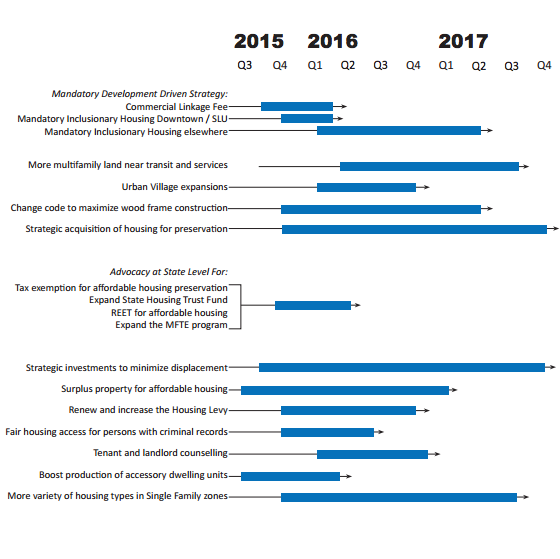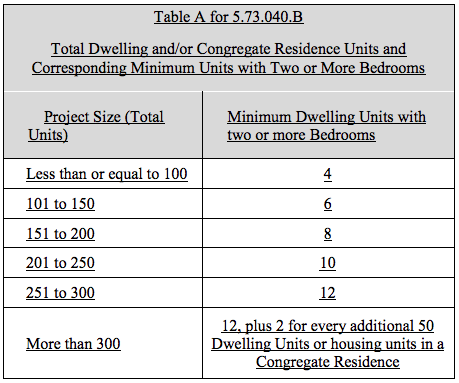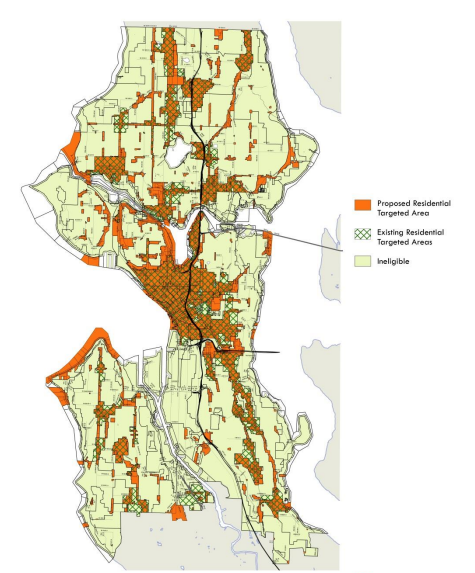The Seattle City Council met yesterday afternoon for the regular full Council meeting to vote on important policies affecting housing. Sitting first on the agenda, the Council considered a resolution (Resolution 31609) to set the overarching policy framework and implementation timeline for the Mayor’s Housing Affordability and Living Agenda (HALA) recommendations, desire for new affordable housing tools from the State, and larger housing goals through 2025. An amended version of the resolution passed on unanimous consent of the Council, although amendments were limited to the Council’s HALA Work Plan itself.

The adopted legislation sets out three broad policy goals:
- Implementation of the Council’s HALA work plan, which begins with fast-tracked policy development on Commercial Linkage Fees and Mandatory Inclusionary Housing regulations this year and wraps up with legislation to allow conversion of single-family homes into multi-dwelling units and reduce and/or remove certain parking requirements in 2017.
- Begin efforts to lobby for new tools to provide affordable housing for households at or below 60% of area median income. Tools that the Council would like, include: authorization for a 0.25 percent increase in the Real Estate Excise Tax to fund affordable housing, increase in the Housing Trust Fund, and new preservation tax exemption to create rent- and income-restricted affordable homes in existing buildings.
- A concurrence with the Mayor’s recommendation that 20,000 new rent- and income-restricted housing units and 30,000 new market rate housing units be made available by the end of 2025. The Council set a goal of implementing strategies that will ensure at least 75% of rent- and income-restricted units are affordable to households earning between 0% and 60% percent of the area median income.
The Council revisited the Multi-Family Tax Exemption (MFTE) Program (Council Bill 118505) to consider some policy changes and a program extension. (The MFTE provides tax exemptions to property owners of multifamily residential projects in targeted areas of the city if 20% of units are set aside for income- and rent-restricted households. Property owners are eligible to participate in the MFTE Program for up to 12 successive years.) Three primary changes were enacted, including:
- Establishment of different affordable unit set-asides for projects with fewer than four units with 2+ bedrooms (Small Unit Program) and projects with four or more dwelling units with 2+ bedrooms (Family Sized Unit Program);
- Expansion of program eligibility areas; and
- A new MFTE Program sunset provision.
The following table is a comparison of the current MFTE Program and new options available to developers and property owners. The changes bring promised revisions to MFTE Program provisions for Small Efficiency Dwelling Units (SEDUs, aka microhousing units) and the graduation of requirements by housing unit type (e.g. congregate units, 1-bedroom, studios, etc.)
| Affordability Requirements | Current Program | New Family Size Unit Program (Projects with 4 or more 2+ bedroom units) | New Small Unit Program (Projects with fewer than 4, 2+ bedroom units) |
|---|---|---|---|
| Affordable Unit Set-Aside | 20% of all unit types, 25% for SEDUs | 20% of all units | 25% of all units |
| Maximum Area Median Income (AMI) for Affordable Units by Unit Type | SEDU – 40% AMI Studio – 65% AMI 1 BR – 75% AMI 2 BR – 85% AMI | Unchanged, except: Congregate Units – 40% AMI 3 BR – 90% AMI | Unchanged, except: Congregate Units – 40% AMI 3 BR – 90% AMI |
If the Family Sized Unit Program is chosen, fewer MFTE dwelling units are required, but a minimum number MFTE dwelling units consisting of 2+ bedrooms kicks in. O’Brien added the provision in committee to incentivize more dwelling units geared toward families. Four such MFTE dwelling units would be required as part of the first 100 units in a project. Additional 2+ bedroom MFTE dwelling units would be required depending upon the total number units in a project as shown in the table below.

Areas eligible for the MFTE Program were revised in two ways. The first change revised program eligibility boundaries as shown in the map below. The second change adds provisions to allow any land zoned in the future for multifamily housing to be included for program eligibility thereby overriding mapped boundaries of the MFTE Residential Targeted Areas.

Councilmember Nick Licata offered two amendments to the legislation: one to extend the MFTE Program to December 31, 2019 and another to add an annual reporting requirement to analyze rent level information for affordable units.
The amendments and ordinance passed on unanimous consent.
Separately from housing policy, a vote on the SR-520 resolution (Resolution 31618) was originally scheduled for the meeting, but was pulled last minute from the agenda. A separate vote will be set for next week when the full Council meets again. The resolution is a particularly important policy document because it is the last best chance to make the SR-520 rebuild better for people walking and biking on and near the corridor. The Washington State Department of Transportation is set to make substantial investments to build city streets, bicycle and walking, and transit infrastructure in the coming years, so getting the policy language right now is imperative.
At last week’s Transportation Committee meeting, eight amendments were proposed by Councilmember Rasmussen and Councilmember Mike O’Brien — with seven gaining approval. One amendment proposed O’Brien stirred a prolonged discussion on the merits of requiring protected bike lanes directly on Montlake Boulevard from E Roanoke St to the University of Washington Station. Rasmussen suggested that the amendment be put on hold pending feedback from the Seattle Bicycle Advisory Board (SBAB), leaving the amendment without a vote in committee. On Friday, the SBAB produced a letter giving their full support for the concept saying:
The Bicycle Advisory Board has consistently advised having Protected Bicycle Lanes on Montlake Boulevard from East Roanoke to the Montlake Bridge as a direct access route for people of all ages and abilities riding bicycles in addition to the other bicycle facilities in the SR520 project. Separated, protected bike lanes are an imperative in this location and in other city locations to meet the Bicycle Master Plan Goals of Safety and Connectivity. The Bicycle Advisory Board has been advising and will continue to advise Protected Bike Lanes throughout the city, including Southeast Seattle, West Seattle and Downtown, to address all high needs of safety improvements for people of all ages and abilities riding bicycles, to achieve the goals of Vision Zero and to insure that the Bicycle Master Plan Goals of Equity, Connectivity and Safety are met.
With this kind of unequivocal support from the SBAB, the O’Brien amendment is likely to find friends on the Council for adoption.
Stephen is a professional urban planner in Puget Sound with a passion for sustainable, livable, and diverse cities. He is especially interested in how policies, regulations, and programs can promote positive outcomes for communities. With stints in great cities like Bellingham and Cork, Stephen currently lives in Seattle. He primarily covers land use and transportation issues and has been with The Urbanist since 2014.



